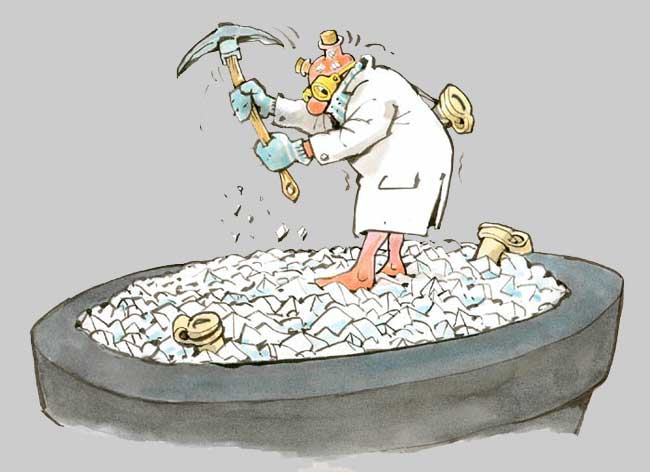|
Overview
Digestions
pGT4ΔB
Electrophoresis
DNA clean-up
Ligation
Fragment isolation
Competent cells
Transformation
Recombinants
pGTλ3758ΔH
Miniprepping
Blotting
Probe Labeling
Hybridisation
Probe Detection
PCR |
Setting-up digestions
Using a Mastermix
What can go wrong?

Restriction enzyme digestions
Restriction enzyme
digestions are performed by incubating double-stranded DNA molecules
with an appropriate amount of restriction enzyme, in its respective
buffer as recommended (and often supplied) by the commercial supplier,
and at the optimal temperature for that specific enzyme.
One enzyme unit is defined as the amount of enzyme needed to completely
digest one microgram of linear double-stranded DNA in one hour at the
appropriate temperature.To cut covalently closed circular (ccc) plasmid
DNA and for unpure DNA preparations more enzyme is needed. Usually, an
(up to 10 times) excess of enzyme is used.
In general for DNA
analysis, you digest 0.2 to 2μg per digest (a minimum amount of
approximately 20 ng per DNA band is needed for visualisation in an
EthBr-containing gel).
The digestion reactions usually
are incubated for 1-3 hours, to ensure complete digestion, at the
optimal temperature for enzyme activity, typically 37 °C.
| 1 |
Check the concentration of
your DNA stocks (they are usually in your box in the -20
°C freezer) and decide how much you want to digest. |
In general: maximally 2
μg
per 20 μl reaction mixture.
For an analytical gel: 20 to 200 ng per expected
DNA band.
For a preparative gel (i.e. to purify DNA
fragments from bands):
up to 1μg per expected band. |
| 2 |
Check the concentrations
of the restriction enzymes to be used. They are usually
stored in the central enzymes -20 °C freezer in the lab;
concentration is mostly between 2 and 10 units/μl. |
Glycerol concentrations higher than 5% inhibit
restriction enzymes.
So, do not use more than 2μl enzyme stock
solution(s) in the 20 μl of reaction mixture, since
enzyme stocks contain 50% glycerol. |
| 3 |
Check the concentration of
the available Digestion Buffer stock solution; usually
5x or 10x concentrated. |
|
| 4 |
Draw a pipetting scheme
for your digestion reactions. Typically: you will set-up
20μl reactions with 2 to 10 units/μg DNA. |
|
| 5 |
Mark your tubes, typically
1.5ml disposable tubes, fill them, mix well, collect by
a few seconds centrifugation and start the reaction by
placing them in a 37 °C waterbath. |
Some helpfull tips:
-
Keep
restriction enzyme stock solution always in ice;
their activity will gradually decrease after
successive exposures to higher temperature.
-
Add
water first, enzyme(s) last when making up multiple
digestions with the same enzyme(s), it's good to
make a stock mix ("mastermix"), see below.
-
When
adding very small volumes, e.g. less than 5μl, pipet
a few times up-and-down to transfer all of the
liquid from the tip. This is especially important
when adding the very viscous (50% glycerol!) enzyme
stock solutions.
-
When
you've touched any liquid already in the tubes,
change the pipet tip.
|
Setting-up multiple digestions using the same enzymes: make a
Mastermix!
A very convenient and accurate way of starting a series of reactions
(e.g. digestions, PCR) is to make a so-called mastermix: a
relatively large amount of mixture that contains
everything-but-one-component of the digestion. If you for example would have to digest a large number of minipreps with the same
enzyme(s), the best way to do this is as follows:
make a large volume of a mixture containing water, concentrated digestion buffer
and enzymes, fill the tubes with an appropriate amount of this mastermix and
add a small amount of the minipreps to the tubes to start the digestion.
When not all DNA molecules
are fully cut by the restriction enzyme(s), some cutting sites in some
of the molecules stay intact. This may result in more DNA fragments than
expected. Such incomplete (or: "partial") digestion can occur for
many reasons:
- bad quality or an insufficient
amount of restriction enzyme
- inaccurate pipetting when handling
very small volumes
- bad quality of the DNA
preparation, i.e. unpure DNA; impurities may prevent optimal
restriction enzyme activity
- wrong buffer and temperature
conditions during the reaction
When linearisation of a plasmid by a single cut was only partial, the
agarose gel will show some OC and CCC form plasmid after such an
incomplete digestion (see About plasmid DNA and gel electrophoresis
in the Electrophoresis section)...
Sometimes, deliberately partial
digestions are used to generate a particular DNA fragment.
|


